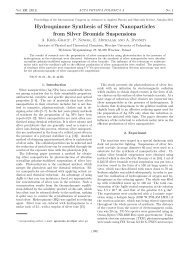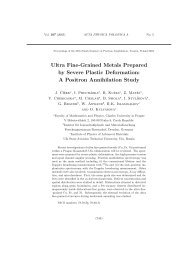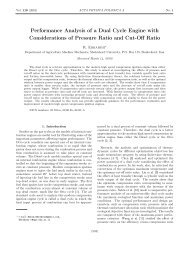Full Text PDF
Full Text PDF
Full Text PDF
Create successful ePaper yourself
Turn your PDF publications into a flip-book with our unique Google optimized e-Paper software.
Optical Sensor to Monitor Pupillary Light Reex 559<br />
contraction interval (2/3CI), which is the time for which<br />
the amplitude reaches 1/3 of the contraction phase value,<br />
1/3 redilatation interval (1/3RI), which represents the<br />
time for which the amplitude reaches 1/3 of the redilatation<br />
phase value, and nally amplitude (A), which represents<br />
the dierence between the maximum and minimum<br />
values of the diameter.<br />
2. Description of the experimental model<br />
and the test stand<br />
Design of the sensor for measuring PLR and PST as<br />
well parameters of the eyelid covering the eyeball were<br />
preceded by laboratory tests. The purpose of the research<br />
was to verify the possibility of identication of<br />
time-varying PLR behavior in relation to the PUI factor<br />
described in the literature. At the same time, the requirements<br />
for the designed optical sensor were collected. The<br />
resolution of the converter, frequency of image acquisition<br />
and required speed of the pupil detection algorithm<br />
were taken into account.<br />
The study was conducted in two stages. The rst step<br />
was research where assumptions were veried. The second<br />
stage consisted of a study of the designed PLR sensor.<br />
The rst phase of the study was preceded with a<br />
series of experimental research of the commercially available<br />
F 2 D Fit-For-Duty device by AMTech. The experimental<br />
model assumed verication of PLR parameter<br />
usability in correlation with results of the pupillography<br />
sleepiness test PST. Research was performed on a group<br />
of 10 volunteers in a laboratory environment during at<br />
night. The average age of participants was 34.8 ± 6.5<br />
years. Each participant was familiarized with the description<br />
of the experiment and agreed to participate in<br />
the study. The PLR measurements were taken on both<br />
eyeballs, which were exposed to a series of ve ashes<br />
with the interval of 30 s. The second phase of the experiment<br />
involved testing the constructed PLR sensor.<br />
Functional tests were also carried out on a group of 10<br />
volunteers. The study took place in an ophthalmology<br />
darkroom, which provided necessary conditions for testing.<br />
Measurements were performed in the identical measurement<br />
workow, as in the case of pilot studies [13].<br />
3. Test results<br />
Initial results showed high usability of the dedicated<br />
parameters characteristic for the PLR in estimating the<br />
level of fatigue and lowered concentration, as well as<br />
high correlation with the PUI index (Table I). Statistical<br />
analysis was performed using conventional statistical<br />
methods based on variance analysis. They were multi-<br />
-dimensional, multi-factor analyses of identiable variables<br />
from the pupillary reex signal, categorized by Person,<br />
Task, Eye variables and the light excitation sequence<br />
(Prole). In the subsequent measurement times, parameters<br />
were estimated that described the relative amplitude<br />
and contraction velocity of the pupillary reex (Table II).<br />
Measurements for each person were made four times with<br />
the average interval of 2 h between hours 11.00 PM and<br />
6.30 AM. These changes proved to be statistically significant.<br />
Investigations shown that the dierence between the<br />
rst and last measurement point is 3.07%. With the average<br />
value of the observed changes in pupil width of<br />
1.77 mm, the required measurement accuracy could not<br />
be less than 0.09 mm. This value is necessary to design<br />
the sensor in order to observe the changes in the work<br />
of the ANS for the experimental model adopted. It was<br />
necessary to analyze the behavior of the contraction velocity<br />
parameter in order to determine the required speed<br />
of the optical system. The scope of averaged parameter<br />
values for the rst and last measurement was 0.5 mm/s.<br />
It means that the measurement resolution cannot be less<br />
than 0.25 mm/s. These assumptions were adopted in the<br />
design of the PLR optical sensor.<br />
TABLE I<br />
Table showing the values of the rPUI and rPUI rel parameters<br />
in successive measurement points.<br />
rPUI<br />
rPUI rel<br />
task N mean st.d. mean st.d.<br />
All 398 0.83 0.42 0.20 0.29<br />
0 99 0.62 0.25 0.00 0.00<br />
1 102 0.76 0.35 0.13 0.15<br />
2 98 0.91 0.40 0.28 0.17<br />
3 99 1.02 0.55 0.39 0.45<br />
TABLE II<br />
Table showing the values of the relative amplitude<br />
and contraction velocity indicators in successive<br />
measurement points.<br />
Rel. amplitude Contr. velocity<br />
Task N mean st.d. mean st.d.<br />
0 79 24.21 5.11 3.98 0.82<br />
1 76 25.53 5.28 4.21 0.89<br />
2 80 26.22 5.36 4.29 0.83<br />
3 79 27.28 5.47 4.49 0.87<br />
4. Optical sensor to monitor pupillary<br />
light reex<br />
In pupillary light reex testing, it is most important<br />
to determine the parameters of pupil response to light<br />
stimulation with a specic duration (t = 250 ms). The<br />
measurement method for PLR determines the design of<br />
the illuminator control system, image acquisition system<br />
and software. In the adopted implementation the change<br />
of pupil size in time is determined by analyzing the motion<br />
camera image. The acquired image is recorded in the<br />
near-infrared band (λ = 850 nm) by the Optitrack V120<br />
camera. The red KPTD-3216SURC LED with the wavelength<br />
of λ = 640 nm was used as an excitation source.





